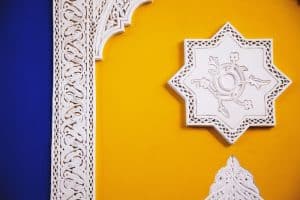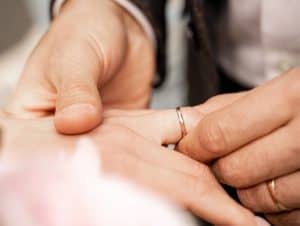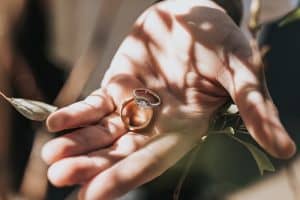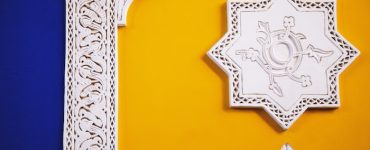The exchange of wedding rings is one of those memories of your big day that will continue to linger in your heart and mind for many years to come. More than the dazzling gowns and suits, the fresh flowers, and the lovely decorations, the exchange of rings is an important element that symbolizes your union.

But why do couples exchange wedding rings, though?
The exchange of wedding rings is a symbolic act of commitment and love that carries a very significant meaning. It is a tradition that has seen changes and adaptations in many different ways through the centuries. However, it continues to be as important as it was for mankind’s ancestors that lived many generations before.
The wedding ring exchange as well as the lifetime commitment of wearing the rings to show your devotion to each other can also have a unique and special meaning to you and your partner.
Who Goes First During the Exchange of Wedding Rings?
The groom traditionally goes first when exchanging wedding rings. While many couples opt to stick to tradition, there is no such rule that stops you from making some tweaks. If you or your partner don’t feel comfortable having an audience watching you, the one who feels more confident can go first to make the other less nervous when his or her turn comes.
Are the Exchange of Wedding Rings and Wedding Vows the Same?
This is one aspect where many couples often find themselves confused. Some have no idea if wedding ring exchange and wedding vows are different or the same. Others were unsure which one comes first.
Trying to figure out the difference between these two can be a bit tricky, even more so if you don’t have a lot of experience when it comes to weddings.
To give you an idea, the wedding vows should be exchanged first. These vows are basically the promises of devotion and love that you and your partner will make to each other with your family, loved ones, and friends around you.
After saying each of your vows, the exchange of wedding rings will come next. The wedding ring exchange is often accompanied by a short set of words that you and your partner have picked. You will then recite these words to each other while exchanging rings.
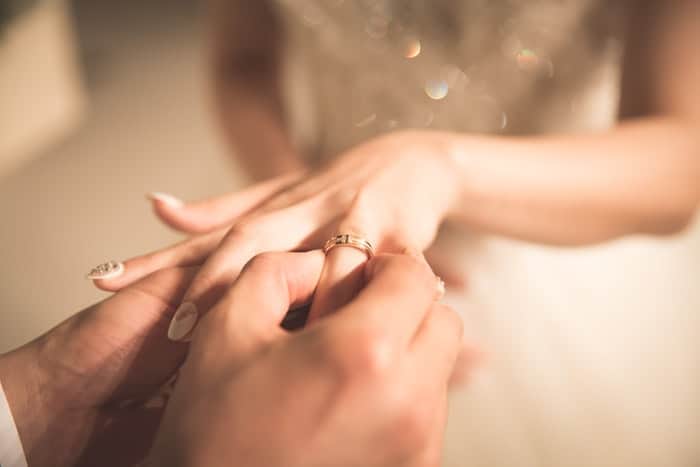
When Did the Tradition of Wedding Ring Exchange Start?
The tradition of exchanging wedding rings goes back many centuries. Most historians also believe that it was started by the ancient Egyptians over 4,000 years ago. The very first wedding rings were made of rushes, sedges, and reeds that were then woven to form a circle that symbolizes endless love.
These rings obviously didn’t last that long, and sturdier rings made of ivory, leather, or bone soon replaced them. Just like how it is done today, the Egyptians also wore their wedding bands on their left hand’s fourth finger. It is because of their belief that the finger had a vein that goes straight to the heart.
Exchange of Wedding Rings During the Roman Times
The Romans soon adopted the tradition started by the Egyptians but this time, they put their own spin on it. What started to be a symbol soon became a symbol of ownership during Roman times. Their wedding rings were made of iron to represent strength and permanency.
Historians also believed that the Romans were the ones who first engraved their wedding rings with the images of doves, lyres, clasped hands, and sentiments at times.
It continued to be the norm until 860 A.D. came and the Church considered the intricate bands as somewhat wicked. Wedding rings soon became less ornate after this.
Wedding Rings in Different Cultures
Every culture also has its own spin on the wedding ring, and each has its own unique meaning.
Gimmel Rings
It was in the 14th and 15th centuries when gimmel rings became the rage in Europe. The rings were made of two completely different bands that fit well together. Gimmel rings were a symbol of unity and marriage. Throughout the period of engagement, the bride and groom would each wear one part of the ring. The bride will then wear both parts of the ring together after the wedding ceremony is over.
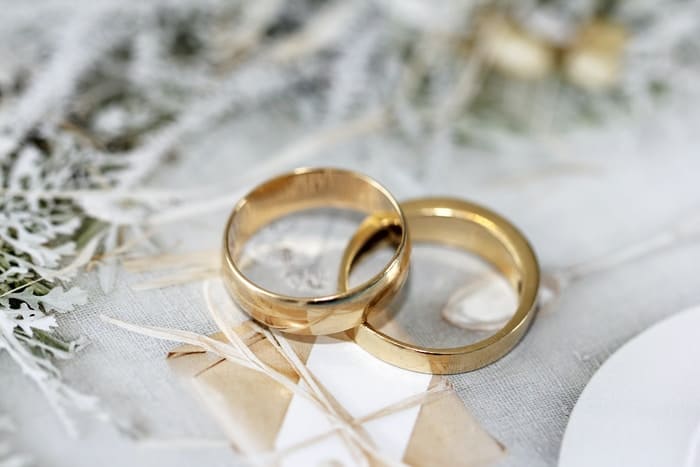
Puzzle Rings of the Middle East
When the Middle East started adopting the tradition centuries ago, the groom gave the bride a puzzle ring. The puzzle rings were made of different brands that would form a ring in a perfect round shape when assembled.
The rings didn’t only offer a tricky brain teaser because it is also believed that these helped ensure that the bride will remain faithful. The puzzle rings were complex just like the wire puzzles of today. There was also a belief that if the ring was removed from the wearer’s finger, the bride won’t be able to assemble it again.
Thimbles
The Puritans in Colonial America believed that jewelry was pointlessly indulgent and flashy. Instead of giving a ring to the bride, the groom would give her a thimble instead.
But most ladies didn’t agree with their devout fellow colonists, with many of them usually removing the thimble’s top that left them with a wedding band.
What Happens After the Exchange of Wedding Rings?
After the bride and groom have exchanged their vows and their wedding rings, the pronouncement is the last part of the wedding ceremony. It is when the priest, justice of the peace, minister, or whoever was the officiant of the wedding will pronounce the bride and groom as a newly married couple. This is usually accompanied by the famous phrase of pronouncing the couple as husband and wife.
In the case of a religious ceremony like a Catholic wedding, for instance, the ceremony may also end with something that invokes the name of the Father, the Son, and the Holy Spirit before pronouncing the couple as husband and wife.
The exchange of wedding rings is an important aspect of the wedding ceremony, and it is a tradition that goes far back thousands of years.



